+ Open data
Open data
- Basic information
Basic information
| Entry | Database: PDB / ID: 1fjd | ||||||
|---|---|---|---|---|---|---|---|
| Title | HUMAN PARVULIN-LIKE PEPTIDYL PROLYL CIS/TRANS ISOMERASE, HPAR14 | ||||||
 Components Components | PEPTIDYL PROLYL CIS/TRANS ISOMERASE (PPIASE) | ||||||
 Keywords Keywords |  ISOMERASE / ISOMERASE /  Parvulin / Peptidyl prolyl cis/trans isomerase / RIKEN Structural Genomics/Proteomics Initiative / RSGI / Parvulin / Peptidyl prolyl cis/trans isomerase / RIKEN Structural Genomics/Proteomics Initiative / RSGI /  Structural Genomics Structural Genomics | ||||||
| Function / homology |  Function and homology information Function and homology informationpreribosome / bent DNA binding / localization /  peptidylprolyl isomerase / peptidylprolyl isomerase /  peptidyl-prolyl cis-trans isomerase activity / spindle / rRNA processing / peptidyl-prolyl cis-trans isomerase activity / spindle / rRNA processing /  chromosome / chromosome /  double-stranded DNA binding / double-stranded DNA binding /  mitochondrial matrix ...preribosome / bent DNA binding / localization / mitochondrial matrix ...preribosome / bent DNA binding / localization /  peptidylprolyl isomerase / peptidylprolyl isomerase /  peptidyl-prolyl cis-trans isomerase activity / spindle / rRNA processing / peptidyl-prolyl cis-trans isomerase activity / spindle / rRNA processing /  chromosome / chromosome /  double-stranded DNA binding / double-stranded DNA binding /  mitochondrial matrix / mitochondrial matrix /  nucleolus / nucleolus /  DNA binding / DNA binding /  RNA binding / RNA binding /  nucleoplasm / nucleoplasm /  nucleus / nucleus /  cytoplasm cytoplasmSimilarity search - Function | ||||||
| Biological species |   Homo sapiens (human) Homo sapiens (human) | ||||||
| Method |  SOLUTION NMR / Simulated annealing method starting with an extended strand SOLUTION NMR / Simulated annealing method starting with an extended strand | ||||||
| Model type details | minimized average | ||||||
 Authors Authors | Terada, T. / Shirouzu, M. / Fukumori, Y. / Fujimori, F. / Ito, Y. / Kigawa, T. / Yokoyama, S. / Uchida, T. / RIKEN Structural Genomics/Proteomics Initiative (RSGI) | ||||||
 Citation Citation |  Journal: J.Mol.Biol. / Year: 2001 Journal: J.Mol.Biol. / Year: 2001Title: Solution structure of the human parvulin-like peptidyl prolyl cis/trans isomerase, hPar14. Authors: Terada, T. / Shirouzu, M. / Fukumori, Y. / Fujimori, F. / Ito, Y. / Kigawa, T. / Yokoyama, S. / Uchida, T. | ||||||
| History |
|
- Structure visualization
Structure visualization
| Structure viewer | Molecule:  Molmil Molmil Jmol/JSmol Jmol/JSmol |
|---|
- Downloads & links
Downloads & links
- Download
Download
| PDBx/mmCIF format |  1fjd.cif.gz 1fjd.cif.gz | 624.1 KB | Display |  PDBx/mmCIF format PDBx/mmCIF format |
|---|---|---|---|---|
| PDB format |  pdb1fjd.ent.gz pdb1fjd.ent.gz | 540.2 KB | Display |  PDB format PDB format |
| PDBx/mmJSON format |  1fjd.json.gz 1fjd.json.gz | Tree view |  PDBx/mmJSON format PDBx/mmJSON format | |
| Others |  Other downloads Other downloads |
-Validation report
| Arichive directory |  https://data.pdbj.org/pub/pdb/validation_reports/fj/1fjd https://data.pdbj.org/pub/pdb/validation_reports/fj/1fjd ftp://data.pdbj.org/pub/pdb/validation_reports/fj/1fjd ftp://data.pdbj.org/pub/pdb/validation_reports/fj/1fjd | HTTPS FTP |
|---|
-Related structure data
| Similar structure data | |
|---|---|
| Other databases |
- Links
Links
- Assembly
Assembly
| Deposited unit | 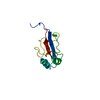
| |||||||||
|---|---|---|---|---|---|---|---|---|---|---|
| 1 |
| |||||||||
| NMR ensembles |
|
- Components
Components
| #1: Protein | Mass: 11330.182 Da / Num. of mol.: 1 / Fragment: RESIDUES 28-131 / Mutation: A28G, Q29S Source method: isolated from a genetically manipulated source Source: (gene. exp.)   Homo sapiens (human) / Organ: LUNG Homo sapiens (human) / Organ: LUNG / Plasmid: PGEX / Production host: / Plasmid: PGEX / Production host:   Escherichia coli (E. coli) / References: UniProt: Q9Y237 Escherichia coli (E. coli) / References: UniProt: Q9Y237 |
|---|
-Experimental details
-Experiment
| Experiment | Method:  SOLUTION NMR SOLUTION NMR | ||||||||||||
|---|---|---|---|---|---|---|---|---|---|---|---|---|---|
| NMR experiment |
| ||||||||||||
| NMR details | Text: This structure was determined using standard 3D triple resonance techniques. |
- Sample preparation
Sample preparation
| Details |
| |||||||||
|---|---|---|---|---|---|---|---|---|---|---|
| Sample conditions | Ionic strength: 100mM / pH: 6.5 / Pressure: 1 atm / Temperature: 298 K | |||||||||
Crystal grow | *PLUS Method: other / Details: NMR |
-NMR measurement
| NMR spectrometer | Type: Bruker DRX / Manufacturer: Bruker / Model : DRX / Field strength: 600 MHz : DRX / Field strength: 600 MHz |
|---|
- Processing
Processing
| NMR software |
| ||||||||||||||||||||
|---|---|---|---|---|---|---|---|---|---|---|---|---|---|---|---|---|---|---|---|---|---|
| Refinement | Method: Simulated annealing method starting with an extended strand Software ordinal: 1 Details: Floating chirality method was used to determine the structure of prochiral methylenes and methyls. | ||||||||||||||||||||
| NMR representative | Selection criteria: minimized average structure | ||||||||||||||||||||
| NMR ensemble | Conformer selection criteria: structures with the lowest energy Conformers calculated total number: 100 / Conformers submitted total number: 20 |
 Movie
Movie Controller
Controller




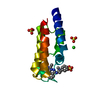
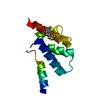
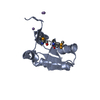

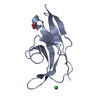

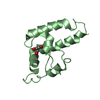
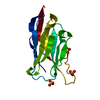

 PDBj
PDBj

